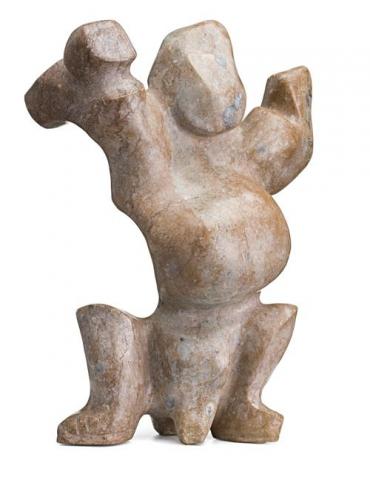SUPERMAN (NIETZSCHE), 1950
Danila Vassilieff
Lilydale marble
37.0 cm height
signed and dated on base: V / 1950
The Pro Hart Collection, Broken Hill, New South Wales
St John Moore, F., Vassilieff and his art, Oxford University Press, Melbourne, 1982, cat. s72, p. 95 (illus.)
Significantly, at the inaugural exhibition of Vassilieff's sculpture alongside forty of his Fitzroy street scenes at Tye's Gallery in April 1949, the artist proclaimed the third-dimension as his 'real work' - a sentiment echoed in the considerable attention which these pieces attracted vis a vis his paintings.1 Highly expressive and satirical, these preliminary works depicting specific public figures - the Cossack under whom he had served in One-Eyed General, 1947; the then Lord Mayor of Melbourne in Important Person, 1947; and the Honourable Thomas White, Federal Minister for the electorate of Balaclavain Election Speaker, 1947, - vehemently denounced the complacency and pomposity which Vassilieff perceived in politicians and leaders generally. Also featured were Vassilieff's subsequent, less provocative investigations of the medium - anthropomorphic sculptures which, departing from the figurative animistic tradition, betray a close association with the unpolished semi-abstract forms of Henry Moore.
Executed in 1950, the present Superman (Nietzsche) elucidates Vassilieff's evolution as a sculptor with Moore's principles of composition now informed by the lively Russian folk carving of his youth, as well as more recent memories of a range of cultural artifacts encountered on his travels. Carved from the unique medium of Lilydale marble - today renowned for its wide variety of colours and textures, but at the time virtually undiscovered by sculptors - the work is more assertive, more vigorous than his earlier endeavours. Like Bloke Painting and Boy from the same year, Superman is at once primitive and sophisticated - primitive in its basic shapes, bold expression and exaggeration; sophisticated in the exceptional plasticity, and unity between form and material. Although strikingly reminiscent of the British Vorticists - and specifically, Henri Gaudier's Red Stone Dancer, 1913 in the Tate Gallery, of which Vassilieff would no doubt have been aware from his recent sojourn in London and acquaintance with the artist's biographer, H.S. Ede - the present work does not appropriate Gaudier so much as reveal the similarity between each sculptor's sources, in one instance early African art and the other, Russian folk carving.
Arguably less apparent is the motivation underlying Vassilieff's specific choice of title for the present work. In stark contrast to the American superhero battling for truth, justice and 'the American way', Nietzsche's Superman' (or more accurately 'Overman' when translated from the german Ubermensch) has achieved a state of being where he is no longer affected by pity, suffering, tolerance of the weak, the power of the soul over the body, the belief in an afterlife or the corruption of modern values. He determines his own values to cope with a constantly changing world - and accordingly, himself occupies a state of continual transformation, of rebirth and growth. One can only speculate that Vassilieff, preoccupied with change as a result of his turbulent life, identified with this concept of the self-perfecting 'creative genius' for, as subsequent artists and writers exploring Nietzsche have suggested, the Ubermensch - a synthesis of Dionysian passion and Apollonian control - is 'the only one who actually does live his life as a work of art.'1
1. St John Moore, F., Vassilieff and his art, Oxford University Press, Melbourne, 1982, p. 87
VERONICA ANGELATOS
